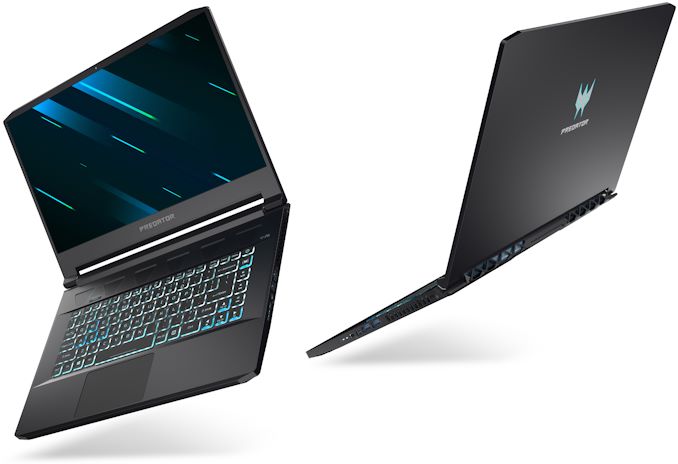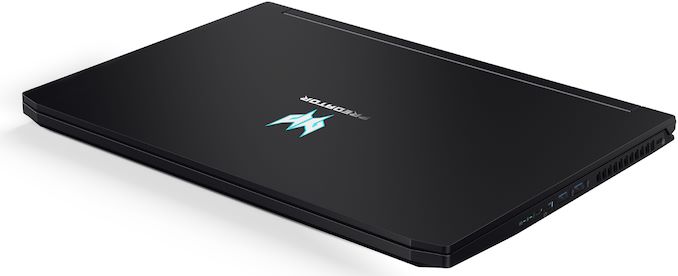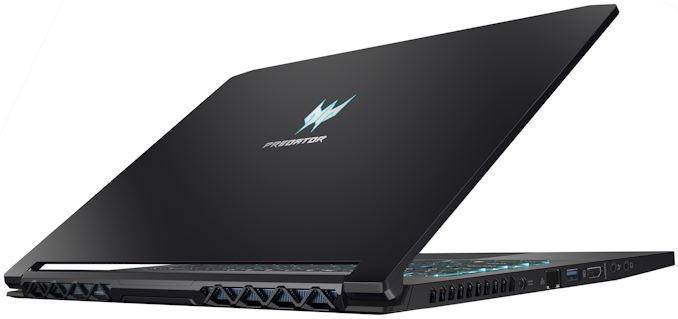Blink Quickly: Acer’s Predator Triton 500 Gets a 300 Hz Display
by Anton Shilov on September 4, 2019 6:30 AM EST- Posted in
- Notebooks
- Acer
- Intel
- Laptops
- NVIDIA
- GeForce RTX
- 300Hz
- Predator Triton 500

Introduced earlier this year, Acer’s Predator Triton 500 turned out to be a formidable 15.6-inch gaming PC that brought together rather extreme performance and relatively compact dimensions. Starting this Fall, the machine will also get a display featuring a 300 Hz refresh rate, one of the first in the industry.
The Acer Predator Triton 500 packs Intel’s six-core Core i7-8750H processor along with NVIDIA’s GeForce RTX 2060 or RTX 2080 with Max-Q into an all-metal chassis featuring a z-height of just 17.9 mm. The system can be further equipped with 16 GB or 32 GB of DDR4 memory, up to two 512 GB PCIe 3.0 x4 SSDs in RAID 0 mode for ultimate storage performance, and all the other things that you come to expect from a gaming-grade laptop.
In a bid to make the Predator Triton 500 even more appealing to demanding gamers and esports professionals, Acer will offer it with a Full-HD display featuring a 300 Hz refresh rate as well as a 3 ms GtG response time. This LCD will of course cost a premium and will consume a lot of power, but since it is aimed at gamers requiring ultimate experience and performance, these are not the primary concerns.
Acer has not disclosed exact configurations of the Predator Triton 500 with a 300 Hz display or their prices, but it is natural to expect the laptop to use the fastest GPU possible in a bid to take advantage of the extremely fast LCD.
Related Reading:
- The Acer Predator Triton 500 Laptop Review: Going Thin with GeForce RTX 2080
- Acer at CES 2019: Predator Triton Gaming Laptops With RTX GPUs
Source: Acer












10 Comments
View All Comments
yeeeeman - Wednesday, September 4, 2019 - link
This refresh rate thing is getting ridiculous now. Just make it 1Ghz refresh rate and call it a day.nathanddrews - Wednesday, September 4, 2019 - link
That's the goal!skavi - Thursday, September 5, 2019 - link
you mean KHz? you're about 6 orders of magnitude off lol.TheWereCat - Wednesday, September 4, 2019 - link
300Hz vs 240Hz seems impressive but...240Hz is 4.16ms per frame
300Hz is 3.33ms per frame
so a 0.83ms improvement which is ridiculously small difference and very likely unnoticeable, especially when considering the fact that there is likely no game that matters which will run at perfectly locked 300FPS with no frame time variance as that will make the 0.83ms "advantage" null.
It's nice to see refresh rates going up but in this case it's nothing but a marketing gimmick.
It's a waste to have this kind of display on a laptop where you will be CPU limited most of the time before you can reach 300FPS.
Really the only advantage as of right now is that this will make tearing even less noticeable... if you don't have adaptive sync for some reason.
yetanotherhuman - Wednesday, September 4, 2019 - link
It's utterly pointless, and just marketing. I honestly am still happy when I can lock at 60, but I don't twitch game these days (although even back in the day that was also at 60, unless we go back to to CRTs)mdrejhon - Sunday, September 8, 2019 - link
The only way to get CRT motion clarity without flicker/strobing/phosphor is roughly 1ms refresh cycles. The only way to do that without black period is 1000 unique 1ms refresh cycles, aka 1000fps @ 1000Hz for blurless sample-and-hold.The refresh rate race is beneficial for other reasons such as the holy grail -- strobless ULMB. Full-brightness lagless strobeless HDR ULMB. CRT clarity in a sample-and-hold display!
surt - Wednesday, September 4, 2019 - link
It's all about minimum time to react to an event in the game engine. On average you get that new information into your brain 0.41ms faster on the 300hz display, and that is additive with all the other sources of latency. Human reaction time is on the scale of 100ms, so this would impose an 0.5% advantage. Small, but enough to expect it to flip the result of, for example, 1 kill shot every 200. Think a pro gamer won't mind losing one out of every 200 contests just by virtue of his inferior hardware?TheWereCat - Wednesday, September 4, 2019 - link
:D please...mdrejhon - Sunday, September 8, 2019 - link
There are other human-visible benefits of ultra-high-Hz.(1) Motion blur halves when you double Hz. Good for browser scrolling Etc.
(2) Phantom array and stroboscopic effects.
The only way to get CRT motion clarity without flicker/strobing/phosphor is roughly 1ms refresh cycles. The only way to do that without black period is 1000 unique 1ms refresh cycles, aka 1000fps @ 1000Hz for blurless sample-and-hold.
NVIDIA and VR scientists have confirmed too. See https://www.blurbusters.com/1000hz-journey
4K and 8K used to be 5-figure curiousities. Eventually ultra-Hz will be cheap additions. The refresh rate race to retina refresh rates makes lower Hz cheaper.
mdrejhon - Sunday, September 8, 2019 - link
Things like frame rate amplification technologies will make it possible to cheap GPUs to do higher frame rates in the coming decade: https://www.blurbusters.com/frame-rate-amplificati...